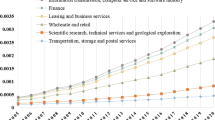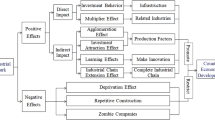Abstract
This paper uses the green total factor productivity (GTFP) to measure the level of high-quality economic development, and uses the partial Durbin model and Partial differential method for spatial regression model to explore the impact of producer service industry agglomeration on high-quality economic development and its sources. This paper analyzes the heterogeneity effect of producer services specialized agglomeration and diversified agglomeration on high-quality economic development in Chengdu Chongqing three urban agglomerations, and empirically tests the local direct effect and intercity indirect effect of producer services agglomeration on high-quality economic development in urban agglomerations. Based on the empirical results, this paper discusses the mode selection and policy recommendations of industrial agglomeration of producer services to promote the high-quality economic development of urban agglomeration.
Fund Project: ShenZhen Institute of information technology, school level doctoral program of Social Sciences–Research on the high quality development of ShenZhen industrial system under the new development pattern of double cycle, SZIIT2021SK010.
Access this chapter
Tax calculation will be finalised at checkout
Purchases are for personal use only
Similar content being viewed by others
Notes
- 1.
GTFP considers “energy consumption” and “environmental pollution”, Scientific integration of innovation driven and green development concept, relative to total factor productivity (TFP), can better reflect the requirements of high-quality economic development in the new era.
References
Sun, B., Ding, S.: Is big city beneficial to the economic growth of small city: evidence from the Yangtze River Delta urban agglomeration. Geograph. Res. 35(9), 1615–1625 (2016)
Mei, Z., Xu, S., Ou, Y., et al.: Spatiotemporal evolution of urban spatial interaction in Pearl River Delta Urban Agglomeration in recent 20 years. Geoscience 32(6), 694–701 (2012)
Ke, S., Xia, J.: Agglomeration effect and backflow effect of Central Plains urban agglomeration. China Soft Sci. (10), 93–103 (2010)
Sun, D., Zhang, J., Hu, Y., et al.: Analysis of the formation mechanism of “metropolitan shadow area” based on industrial spatial connection – a comparative study of Yangtze River Delta urban agglomeration and Beijing Tianjin Hebei urban agglomeration. Geograph. Sci. 33(9), 1043–1050 (2013)
Wang, T., Zeng, J.: Spatial pattern analysis of intercity competition and cooperation of urban agglomeration in the middle reaches of the Yangtze River – based on the perspective of urban competitiveness and spatial interaction. Trop. Geograp. 34(3), 390–398 (2014)
Zhang, X., Chen, S., Liao, C., et al.: Spatial spillover effect of economic development in Beijing Tianjin Hebei region. Geograph. Res. 35(9), 1753–1766 (2016)
Yu, Y., Gao, X., Wei, P.: The impact of producer services agglomeration on the high quality economic development of urban agglomerations: a case study of the three major urban agglomerations in the Yangtze River economic belt. Urban Probl. (7), 56–66 (2020)
Chen, A., Partridge, M.D.: When are cities engines of growth in China? Spread and backwash effects across the urban hierarchy. Reg. Stud. 47(8), 1313–1331 (2013)
Wang, F., Xie, J.: A study on the growth rate of green total factor productivity of provinces in China. China Popul. Sci. (2), 53–62 (2015)
Li, B., Qi, Y., Li, Q.: Fiscal decentralization, FDI and green total factor productivity: an empirical test based on panel data dynamic GMM method. Int. Trade Issues (7), 119–129 (2016)
Zhang, J., Tan, W.: Study on the green total factor productivity in main cities of China. Proc. Rijeka Sch. Econ. 34(1), 215–234 (2016)
Liu, H., Li, C., Peng, Y.: Research on the regional gap and regional collaborative improvement of green total factor productivity in China. China Popul. Sci. (4), 32–43 (2018)
Zheng, Q.: The impact of urbanization on green total factor productivity – an analysis based on the threshold effect of public expenditure. Urban Issues (3), 48–56 (2018)
Li, M., Wang, J.: The quality of foreign direct investment and the growth of green total factor productivity in China. Soft Sci. 33(9), 13–20 (2019)
Jin, B.: Economic research on “high quality development”. China's Ind. Econ. (4), 5–18 (2018)
Ma, R., Luo, H., Wang, H., Wang, T.: Research on evaluation index system and measurement of high quality development of regional economy in China. China Soft Sci. (7), 60–67 (2019)
Liu, S., Zhang, S., Zhu, H.: Measurement of national innovation driving force and its effect on high-quality economic development. Res. Quant. Econ. Technol. Econ. (4), 3–23 (2019)
Zhang, Y., Dong, Q., Ni min.: Differentiation between the development of service industry and “structural slowdown” –also on building a modern economic system with high quality development. Econ. Trends (2), 23–35 (2018)
Li, H., Shi, J.F.: Energy efficiency analysis on Chinese industrial sectors: an improved super - SBM model with undesirable outputs. J. Clean. Prod. (65), 97–107 (2014)
Shan, H.: Re estimation of China's capital stock K: 1952–2006. Res. Quant. Econ. Technol. Econ. (10), 17–31 (2008)
Hall, R.E., Jones, C.I.: Why do some countries produce so much more output per worker than others? Q. J. Econ. 144(1), 83–116 (1999)
Tu, Z.: Coordination of environment, resources and industrial growth. Econ. Res. (2), 93–105 (2008)
Duranton, G., Puga, D.: Diversity and specialization in cities: why, where and when does it matter? Urban Stud. (3), 533–555 (1999)
Ke, S., Ming, H., Yuan, C.: Synergy and co - agglomeration of producer services and manufacturing: a panel data analysis of Chinese cities. Reg. Stud. 48(11), 1829–1841 (2014)
Xi, Q., Chen, X., Li, G.: Research on the mode selection of China's Urban Producer Services – guided by the improvement of industrial efficiency. China's Ind. Econ. (2), 18–30 (2015)
Keller, W.: Geographic localization of international technology diffusion. Am. Econ. Rev. 92(1), 120–142 (2002)
Elhorst, J.P.: Applied spatial econometrics: raising the bar. Spat. Econ. Anal. 5(1), 9–28 (2010)
LeSage, J., Pace, R.K.: Introduction to Spatial Econometrics, pp. 34–48. CRC Press, Taylor & Francis Group (2009)
Liu, Y., Xia, J., Li, Y.: Agglomeration of producer services and upgrading of manufacturing industry. China’s Ind. Econ. 35(7), 24 (2017)
Author information
Authors and Affiliations
Editor information
Editors and Affiliations
Rights and permissions
Copyright information
© 2022 Springer Nature Switzerland AG
About this paper
Cite this paper
Xu, J., Li, Y. (2022). Research on the Impact of Producer Services Industry Agglomeration on the High Quality Development of Urban Agglomerations in the Yangtze River Economic Belt. In: Serhani, M.A., Zhang, LJ. (eds) Services – SERVICES 2021. SERVICES 2021. Lecture Notes in Computer Science(), vol 12996. Springer, Cham. https://doi.org/10.1007/978-3-030-96585-3_3
Download citation
DOI: https://doi.org/10.1007/978-3-030-96585-3_3
Published:
Publisher Name: Springer, Cham
Print ISBN: 978-3-030-96584-6
Online ISBN: 978-3-030-96585-3
eBook Packages: Computer ScienceComputer Science (R0)




